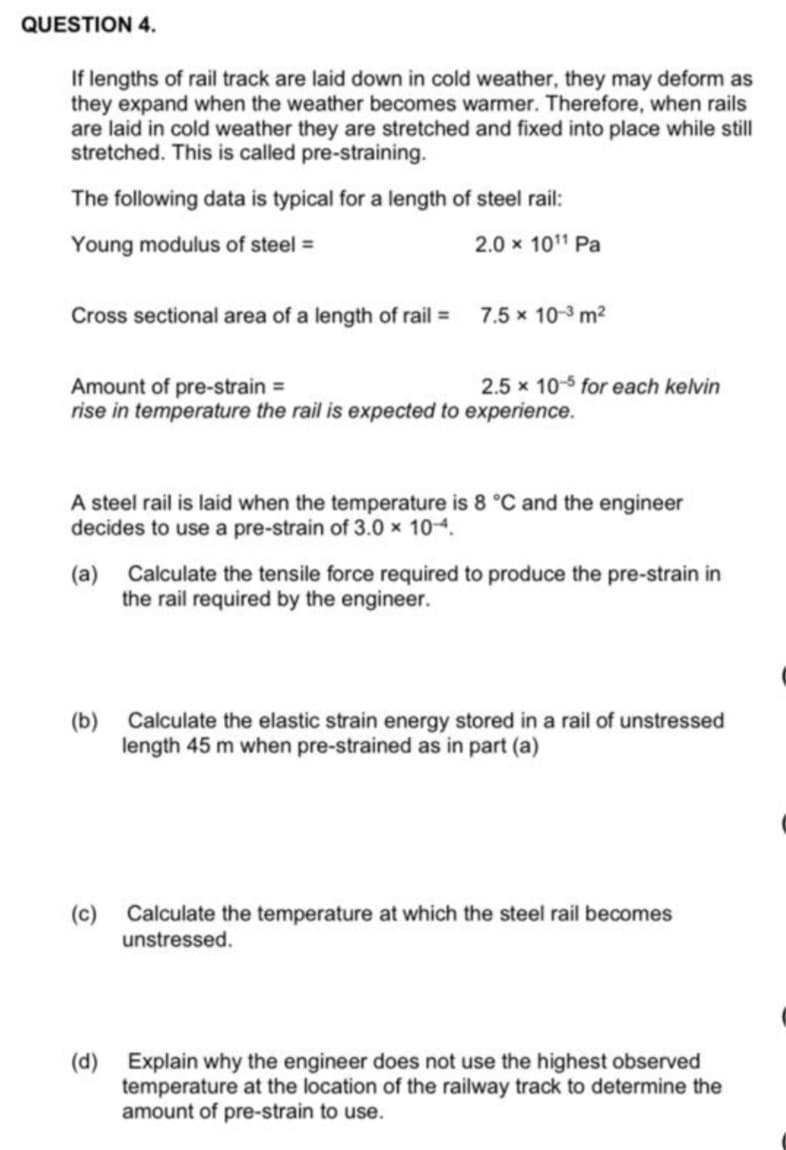If lengths of rail track are laid down in cold weather, they may deform as they expand when the weather becomes warmer. Therefore, when rails are laid in cold weather they are stretched and fixed into place while still stretched. This is called pre-straining. The following data is typical for a length of steel rail: Young modulus of steel = 2.0 x 1011 Pa Cross sectional area of a length of rail = 7.5 x 10-3 m2 2.5 x 10-5 for each kelvin Amount of pre-strain = rise in temperature the rail is expected to experience. A steel rail is laid when the temperature is 8 °C and the engineer decides to use a pre-strain of 3.0 x 10-4. (a) Calculate the tensile force required to produce the pre-strain in the rail required by the engineer. (b) Calculate the elastic strain energy stored in a rail of unstressed length 45 m when pre-strained as in part (a) (c) Calculate the temperature at which the steel rail becomes unstressed.
If lengths of rail track are laid down in cold weather, they may deform as they expand when the weather becomes warmer. Therefore, when rails are laid in cold weather they are stretched and fixed into place while still stretched. This is called pre-straining. The following data is typical for a length of steel rail: Young modulus of steel = 2.0 x 1011 Pa Cross sectional area of a length of rail = 7.5 x 10-3 m2 2.5 x 10-5 for each kelvin Amount of pre-strain = rise in temperature the rail is expected to experience. A steel rail is laid when the temperature is 8 °C and the engineer decides to use a pre-strain of 3.0 x 10-4. (a) Calculate the tensile force required to produce the pre-strain in the rail required by the engineer. (b) Calculate the elastic strain energy stored in a rail of unstressed length 45 m when pre-strained as in part (a) (c) Calculate the temperature at which the steel rail becomes unstressed.
Mechanics of Materials (MindTap Course List)
9th Edition
ISBN:9781337093347
Author:Barry J. Goodno, James M. Gere
Publisher:Barry J. Goodno, James M. Gere
Chapter1: Tension, Compression, And Shear
Section: Chapter Questions
Problem 1.6.7P: A wine of length L = 4 ft and diameter d = 0.125 in. is stretched by tensile forces P = 600 lb. The...
Related questions
Question
pleas

Transcribed Image Text:QUESTION 4.
If lengths of rail track are laid down in cold weather, they may deform as
they expand when the weather becomes warmer. Therefore, when rails
are laid in cold weather they are stretched and fixed into place while still
stretched. This is called pre-straining.
The following data is typical for a length of steel rail:
Young modulus of steel =
2.0 x 101 Pa
Cross sectional area of a length of rail =
7.5 x 10-3 m2
Amount of pre-strain =
rise in temperature the rail is expected to experience.
2.5 x 10-5 for each kelvin
A steel rail is laid when the temperature is 8 °C and the engineer
decides to use a pre-strain of 3.0 x 104.
(a) Calculate the tensile force required to produce the pre-strain in
the rail required by the engineer.
(b) Calculate the elastic strain energy stored in a rail of unstressed
length 45 m when pre-strained as in part (a)
(c)
Calculate the temperature at which the steel rail becomes
unstressed.
(d) Explain why the engineer does not use the highest observed
temperature at the location of the railway track to determine the
amount of pre-strain to use.
Expert Solution
This question has been solved!
Explore an expertly crafted, step-by-step solution for a thorough understanding of key concepts.
This is a popular solution!
Trending now
This is a popular solution!
Step by step
Solved in 3 steps with 3 images

Knowledge Booster
Learn more about
Need a deep-dive on the concept behind this application? Look no further. Learn more about this topic, mechanical-engineering and related others by exploring similar questions and additional content below.Recommended textbooks for you

Mechanics of Materials (MindTap Course List)
Mechanical Engineering
ISBN:
9781337093347
Author:
Barry J. Goodno, James M. Gere
Publisher:
Cengage Learning

Mechanics of Materials (MindTap Course List)
Mechanical Engineering
ISBN:
9781337093347
Author:
Barry J. Goodno, James M. Gere
Publisher:
Cengage Learning